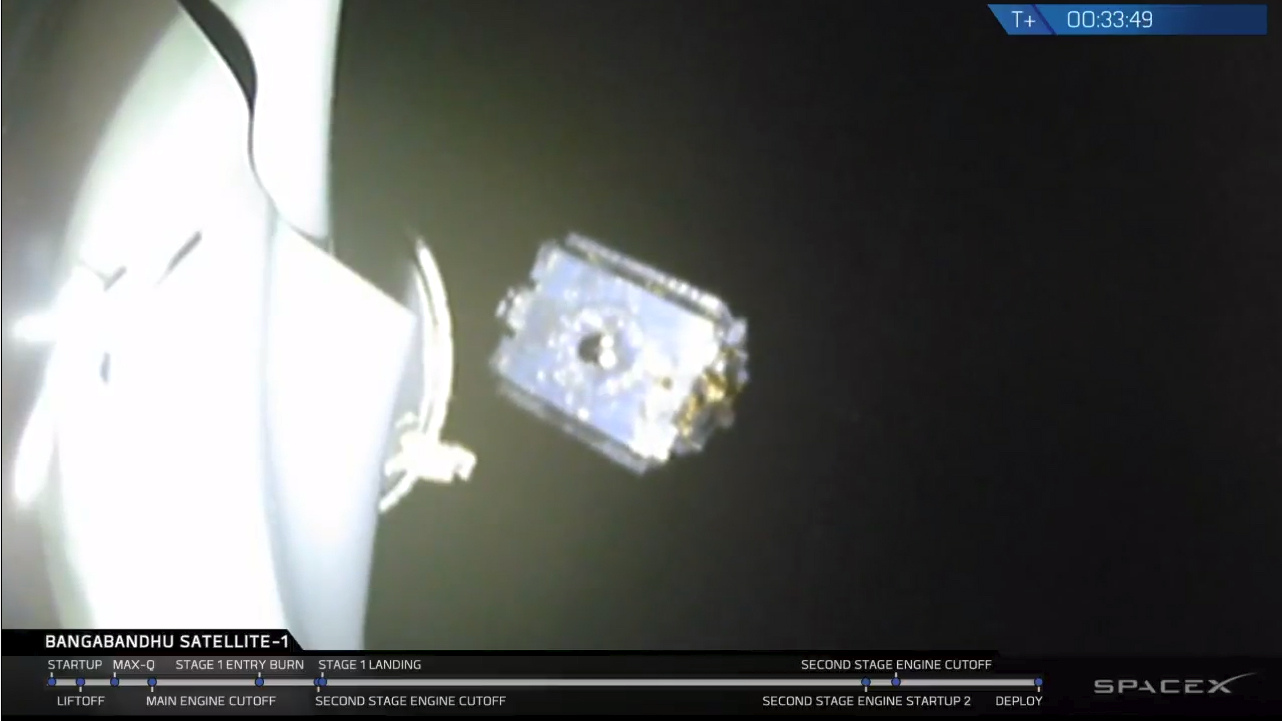How Bangladesh Became SpaceX's First Falcon 9 Block 5 Rocket Customer
WASHINGTON — When it comes to SpaceX's Falcon 9 rocket, the company's most daring customers have been NASA and satellite fleet operator SES. Now add Bangladesh to that mix.
NASA was SpaceX's first customer after Falcon 9's debut flight in 2010, taking its next four consecutive launches for International Space Station resupply missions.
SES of Luxembourg was the first satellite operator to trust SpaceX with the launch of a multimillion-dollar geostationary communications satellite. Following the success of that 2013 mission (and many others), SES backed SpaceX last year by launching on the first Falcon 9 to use a previously flown first stage. [Launch Video: Watch SpaceX's First Falcon 9 Block 5 Rocket Soar]
On Friday (May 11), the Bangladesh Telecommunication Regulatory Commission (BTRC) became the first customer for the Falcon 9 Block 5 — SpaceX's final and most powerful version of the rocket. The Falcon 9 Block 5 includes upgrades to meet NASA commercial crew requirements and U.S. Defense Department criteria. The Block 5 is designed for 10 or more flights using the same first stage booster; previous versions were only designed to handle two or three flights.
NASA and SES both had and have motivation to take bold bets on SpaceX — NASA to cultivate private sector launch options for near-Earth activities, and SES to drive down prices in the global launch sector with new competition. Tomorrow's launch of Bangladesh's 3,500-kilogram Bangabandhu-1 satellite will be SpaceX's 54th Falcon 9, and marks what the company hopes will be the beginning of a new chapter of accelerated reusability.
So how did Bangladesh become the customer of SpaceX's next big milestone?
"It honestly just happened," Sajeeb Wazed, Bangladesh's honorary adviser to the prime minister for information and communications technology, told SpaceNews. "That was basically SpaceX's choice and we were fine with that."
Get the Space.com Newsletter
Breaking space news, the latest updates on rocket launches, skywatching events and more!

Wazed, who is the son of Bangladesh's prime minister, Sheikh Hasina, said BTRC required each bidder angling to build Bangabandhu-1 to also include a first-choice launch vehicle and a backup. The winning bid from Thales Alenia Space listed Arianespace's Ariane 5 as the default launcher, he said. SpaceX's Falcon 9 was the runner-up.
Bangladesh deemed schedule certainty as one of its biggest criteria — a factor that would typically play to the advantage of SpaceX rivals. Arianespace, when prevented from launching for five weeks last spring by local protests that blockaded Europe's spaceport in French Guiana, caught up on three delayed missions in two months, preventing cascading delays on its manifest.
But Arianespace couldn't guarantee Bangladesh that its satellite would launch Dec. 16, 2017 — Bangladesh's "National Victory Day" commemorating the surrender of Pakistani forces during the Bangladesh Liberation War in 1971. Ariane 5 rockets typically carry two satellites at a time, a larger satellite in the upper berth and a smaller satellite in the lower berth. Sharing launch vehicles lowers the cost for satellite operators, but requires their schedules to be in sync. Without that synchronization, delays can ensue.
"Because the size of our satellite only fits in the lower berth of Ariane and they couldn't guarantee us a launch slot by December, we had them switch to the backup," Wazed said. "SpaceX wanted us to go on the Block 5 and we were OK with that."
SpaceX obviously did not meet BTRC's desired launch date, either. While 2017 was the launch provider's most successful year with 18 missions, much of that was playing catch-up on launches delayed by Falcon 9 production strains and failures in 2015 and 2016.
Wazed said he strove to temper expectations about a Victory Day launch, but to no avail.
"I told everybody that wasn't realistic, but it's OK, we will try, you know?"
Bangabandhu-1 is named after Bangabandhu Sheikh Mujibur Rahman, the assassinated founder of Bangladesh and Wazed's grandfather. The satellite carries 26 Ku-band transponders and 14 C-band transponders for television and broadband communications services for the nation and surrounding regions.
This story was provided by SpaceNews, dedicated to covering all aspects of the space industry.
Join our Space Forums to keep talking space on the latest missions, night sky and more! And if you have a news tip, correction or comment, let us know at: community@space.com.
Caleb Henry is a senior analyst for Quilty Analytics and a former staff writer for the space industry publication SpaceNews. From 2016 to 2020, Caleb covered the global satellite industry for SpaceNews, chronicling everything from launches, spacecraft manufacturing and ground infrastructure. Caleb's work has also appeared in NewSpace Global and Access Intelligence. He earned a bachelor's degree in political science with a minor in astronomy from Grove City College.










